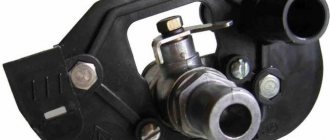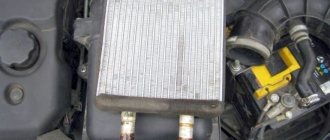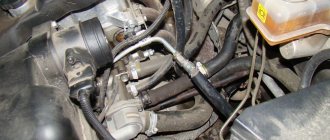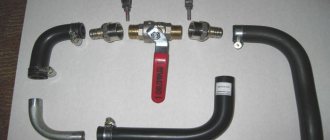Good day, colleagues. Everything ever happens for the first time. This week there was a surprise on the road with the stove (heater). The stove fan began to work only at 3rd speed. Having quickly read the options for solving the problem at work, I decided to buy a heater resistor in the evening. The AVTOVAZ designers, as always, did their best - they shoved this detail far away, so that the owner could practice the Kama Sutra on occasion and not get bored :)))
For those who encountered a similar problem for the first time, don’t guess - it’s a 100% resistor or a block connecting wires to it.
We check and repair the BA3 2109 stove
Interior heating is an important system, which, if it breaks down, can unexpectedly cause discomfort during the cold season. To prevent this, it is necessary that the 2109 stove is maintained in good condition. You should know how we get warm air into the cabin at the exit. Knowing the principle of operation of the engine cooling system and the electric heating ventilation drive, it is not difficult to repair the VAZ 2109 stove with your own hands.
At first glance, the interior heater seems to be a primitive device. Like, the car is driving towards the air flow, air is sucked in, somehow it is heated, and now it is already warm in the cabin. But it is not so. The stove is an auxiliary radiator for the engine cooling system, and air is pumped into the cabin using an electric drive. Therefore, let’s figure out how the stove receives heat from the cooling system and study its electrical circuit. Knowing this, you can identify malfunctions in the heater. Let's find out how to replace the VAZ 2109 stove fan with your own hands.
Radiator check
In most cases, there is a failure of one part of the VAZ-21099 stove. The check can begin with the radiator of the heating system.
In this case, it is advisable to carry out the check after any of the following manifestations appear in the cabin:
- specific smell;
- steam coming from exhaust vents;
- rapid evaporation of the liquid used for cooling.
In such situations, it is initially recommended to check the radiator, and any actions are best carried out after the engine has been turned off and it has had time to cool down.
If, nevertheless, no problems were found in the radiator, most likely the VAZ-21099 heater valve will need to be replaced. However, additional steps are required before this happens.
First of all, you need to carefully inspect the radiator you are using for potential leaks and the condition of its design.
How to check the radiator before understanding whether the heater valve of a VAZ-21099 car needs to be replaced or not.
At the very beginning, you need to disconnect and remove the car battery. After this, the antifreeze is drained from the cooling system. The next stage is the sensor and motor. Now you can remove the casing fasteners and carefully disconnect all the wires. In addition, you can remove the protective cover. The final stage is to disconnect the hoses, slightly tilt the radiator to the side and pull the part out. In most cases, replacement of rubber shock absorbers installed on special radiator holders is required. After removing the unit, you will need to install tight plugs on the pipes or holes to which they are connected. According to this scheme, air is gradually pumped into the radiator
It is important to note that the air pressure should not exceed 0.2 MPa. Then it is allowed to lower the radiator into a bath of water, remembering that the unit must be completely covered
The appearance of air bubbles indicates a leak in the seal and the need to replace the radiator. If there are no bubbles, the unit is only clogged and requires flushing to clean it.
After the preliminary action, care should be taken to adjust the tap of the VAZ-21099 stove and ensure full heating of the car interior.
Place of the heater in the engine cooling system
The stove is part of a closed vacuum coolant circulation system. The main purpose of this system is engine cooling. Thus, the design of the VAZ 2109 stove both helps to heat the interior in cold weather and cools the cylinder block when the engine is running. The entire SOD consists of:
- cooling jackets;
- radiator;
- expansion tank;
- water pump;
- radiator fan;
- thermostat;
- heating radiator - VAZ 2109 stove.
When driving, atmospheric air passes through the air intake into the radiator, the pipes of which contain air that is too hot for the engine. These pipes are cooled by a fan, and the already cooled liquid again enters the cooling jacket (cylinder block and cylinder head) through the water pump. The stove in this antifreeze cycle performs the task of additionally removing hot liquid.
The VAZ 2109 heating fan maintains the desired air temperature in the cabin.
Reasons for the release
The first step is to figure out why the coolant is being thrown out of the expansion tank.
- Wear of CO elements. In particular, we are talking about pipes and connecting hoses. They are constantly exposed to high pressure and temperatures. Therefore, over time, their wear and tear is a completely natural phenomenon. As a result, antifreeze begins to be thrown out.
- Low quality components. If natural wear and tear is typical for used cars and cooling systems that have been in operation for quite a long time, then when using low-quality components, even on a completely new or updated cooling system, serious problems can arise. An example is simple burrs on the neck of the expansion tank. Because of them, the lid does not fit tightly enough, which leads to a gap and the release of antifreeze.
- Expansion tank. Alas, the quality of the plastic from which expansion tanks for the VAZ 2109 are made today leaves much to be desired. Because of it, the plastic simply bursts under high pressure.
- Faulty engine. If the engine itself is not working correctly, the coolant may boil. This leads to damage to the thermostat, radiator, and pump.
From this we can conclude that the quality of the CO directly depends on the technical condition of the car and the quality of the components used.
Coolant emission
Signs of coolant emission
It is important to understand that coolant can be thrown out not only through the expansion tank cap, but also inside the system. It is important to monitor the condition of the CO and identify signs of a leak in time.
Antifreeze evaporates very quickly, so traces of it are not always visible.
- If coolant is released through the reservoir, puddles immediately form under the car.
- If liquid enters the cabin due to a malfunction of the CO, this can be determined by the smell. It has a sweetish tint.
- Antifreeze also often leaks into the engine system. Such a breakdown is determined by white smoke emanating through the exhaust pipe.
- The most unpleasant and dangerous situation is the release of antifreeze into the engine crankcase. If this happens, a white emulsion will appear on the surface of the oil filler cap.
- Periodically checking the space under the timing belt cover will determine whether the pump has failed. If yes, then you will find high humidity there.
Signs of boiling
If there are problems with the engine, antifreeze may simply boil in the CO
There is nothing good about this, so it is important to detect the malfunction in time. There are five main signs of coolant boiling:
- The temperature gauge jumps to 130 degrees;
- White foam appears at the filler neck;
- The engine stops working properly;
- The coolant level in the expansion tank rises sharply;
- White smoke comes out of the exhaust pipe.
Stove design
The interior heater is made up of two plastic casings (left and right). They are connected by fastening brackets. A sealing strand is placed in the grooves of the structure. An electric fan forces forced air into the cabin. It is secured with two screws on top of the stove. It is easily accessible from the combustion engine side.
The stove fan is driven by the impeller of an electric motor. The VAZ 2109 stove motor has two resistor spirals, which provide three rotation speed options. The stove circuit includes an additional resistor to obtain the desired rotation speed. The radiator consists of cooling plates, two rows of tubes and two plastic tanks.
Electrical diagram of the stove and main faults
In the “nine”, the VAZ heating system operates using an electric drive. The instruction manual for the VAZ 2109 high panel shows an electrical diagram of the stove's operation. The interior heater connection diagram consists of:
- fan motor;
- the ignition switch, which turns on the stove;
- operating mode switch;
- additional resistor;
- fuse mounting block (fuse F4 is responsible for the stove in the “nine”).
When the VAZ 2109 stove does not heat well in the cabin, there can be a lot of reasons for this.
Troubleshooting the VAZ heater (stove) system
When the heater (stove) on VAZ cars stops working, especially in winter, you may lose the ability to drive a car altogether. Sometimes, after severe frost, it is impossible to clean the glass for viewing, and if the heater does not function, even getting to the service station will be problematic.
But, as a rule, the stove can be repaired on site without resorting to the services of specialists. Using the diagram and troubleshooting rules, you can do it yourself.
"Folk" way
Folk craftsmen - these are brave and very desperate craftsmen - offer a much less labor-intensive method. The bottom line is that replacing the stove pipes (and the stove itself) is done without draining the coolant and without dismantling the instrument panel. The tools you will need are a set of screwdrivers, rags and a container (small) to drain the liquid from the pipes. In this case, replacing the heater radiator pipes is carried out according to the following scheme:
- Removing the terminals from the battery
- Close the heater tap
- We remove the right front seat (to make it easier to do the work)
- We unscrew the two screws securing the dashboard on the right side, and one screw located in the glove compartment, then, pulling the dashboard towards you, we place a wooden block
- Now there is a gap on the side of the passenger seat and you can get to the pipes and to the heater radiator itself
- Lay a rag on the floor of the cabin and prepare a container to collect the coolant
- Which will spill from the radiator and pipes
- We loosen the clamps of the pipes (photo above) and carefully, one by one, remove them from the radiator, replacing the container. 200 - 300 grams of coolant will drain into it
- Replace the pipes with new ones, and change the clamps, just in case.
- If necessary, unscrew the three bolts that secure the radiator to the stove and pull it down to the right
- We install the pipes and the new radiator in the reverse order.
Here are both methods, choose the one that suits you, and also watch a video on this topic.
Principle of operation
The electrical circuit of the heater consists of:
- electric motor with fan (the fan blows hot air into the cabin, onto the windows and according to adjustments);
- power and speed selection buttons (on the classic VAZ 2101 - 2107, there are only two rotation speeds, on the VAZ 2108 - 2115 there are three speeds, on the VAZ 2110 - 2112 there are three speeds plus a ventilation mode);
- a set of additional resistances to ensure the required rotation speed of the heater fan (step-down, tungsten, turn coils);
- fuse and wiring;
Revision instructions
Remove the air intake box (popularly called “boot”):
- In the interior, unscrew 4 nuts using a 10mm wrench;
- In the engine compartment, an assistant holds the bolts with the same key;
- Remove the air intake.
Remake the “boot” and install a fan in it:
- Cut off part of the plastic a little from the side so that the fan housing does not interfere with the hood lock;
- We cut off all the protruding parts of the fan mount and place it inside the “boot”;
- Secure the fan, securing its housing with sealant.
- We close the space around the fan nozzle with suitable material to prevent air outflow;
- We install the casing with the fan in place, laying the wires;
- We check that the hood closes without problems.
The result should be a design as shown in the video:
The damper can be left in place, but if it is removed, there will be no additional obstruction to the air flow into the cabin.
Troubleshooting
Electrical system diagram of the VAZ heater (stove):
Connection diagram for the electric motor of the interior heater fan on a VAZ 2108, VAZ 2109, VAZ 21099:
1 — mounting block (fuse box);
2 - egnition lock;
3 — additional resistor (resistance);
4 — electric motor of the interior heater;
5 – heater motor switch button;
A - to the positive terminal “30” of the generator;
Repair of the electrical heating system of the VAZ interior
— the fan electric motor does not rotate at any position of the rotation speed switch: most likely, the electric motor itself has failed (the brushes have worn out), or there is no voltage at terminals 2 (ignition switch malfunction) and 4 connectors of the mounting block (fuse F4 has blown), it is also worth checking the mass of the engine itself (it should be no more than 3 ohms). The electric motor on the “classic” VAZ 2101 - 2107, as well as on the VAZ 2121, as well as on the VAZ 2121 “NIVA”: installed in the cabin, immediately behind the heating radiator; in VAZ 2108, 2109, 21099, 2113, 2114, 2115 - under the hood, in the compartment behind the engine shield; in VAZ 2110, 2111, 2112 and Priora 2170 - also under the hood, behind the plastic protection, on Kalina - in the cabin, under the dashboard.
- maximum fan rotation speeds, according to the diagram, are without a switch, and if only the minimum and average speeds do not work for you, then the reason must be looked for in the speed switch button or in additional resistors (values in the diagram);
- sometimes, when you turn on the stove, you hear a very loud noise, high tones (squeaking) and there is no proper airflow. This indicates a malfunction of the heater electric motor itself (jamming of the impeller or armature bearings), in this case either replacement or disassembly and lubrication will help (not recommended, as it helps for a short time);
Installation of new pipes
It is recommended to buy a set of new clamps for a set of new pipes. It is necessary to put them on the pipes before installing them, they must be in a free position, we will tighten them after installing the hoses on the fittings.
If the pipe does not fit well onto the fitting, do not make much effort, just lubricate the fitting. Apply efforts evenly, after successful installation, tighten the metal clamp. It must fit evenly over the entire surface, distortions are not allowed.
In general, the installation of pipes is complete. Upon completion, it is necessary to visually check again and perform a final tightening. Next, fill in new coolant. To do this, we lift the nose of the car so that the new fluid does not create air pockets. Next, turn on the stove to maximum and fill in the liquid. We wait until it completely fills the radiator, heating stove, and block. As soon as the level is at the desired level, you can close the expansion tank cap. At this point the procedure is considered completed.
Upon completion of repairs, periodically check the coolant level. The absence of stains under the car engine, and a constant level of fluid in the expansion tank will tell you that you did everything right, and there is nothing to worry about for the next 3-5 years. In conclusion, I would like to note that this type of repair is not something fantastic, this procedure is carried out frequently and allows you to avoid engine overheating.
Autonomous heating control systems
Autonomous heating systems were installed on VAZ 2110, 2111, 2112, 2170 and others:
1 – electric motor of the heater fan;
2 – additional resistance (resistor);
3 – heater control controller;
4 – mounting block of fuses and relays;
5 – ignition switch (ignition switch);
6 – temperature sensor for air temperature in the cabin;
7 – recirculation switch (air intake from the street or the cabin);
8 – recirculation valve;
9 – micromotor gearbox for heater damper drive (cold or hot air);
A – to the instrument lighting switch;
B – to power supplies.
In such a system, if a malfunction occurs, the search must begin with:
- Checking fuses;
- Checking the control controller (it is necessary to check the supply voltage and the output control voltage);
- Switch and sensors (maximum speed mode must work);
- The electric motor itself (brushes, armature);
Often the micromotor that switches the operating mode fails; when replacing it, it is necessary to set the initial position of the micromotor (by connecting it and turning on all positions in turn);
If a fuse is blown, it must be replaced with the recommended rating.
The most common malfunctions of automatic control systems during operation
VAZ 2110 stove controller
A very common problem on the VAZ 10 series is when any of the stove speeds do not work. In this case, there is only one way out - carrying out a full repair of the hardware control system of the VAZ heater. Before this system begins to fully function, it must receive certain information from specialized devices, which are:
- micromotor reducer transmits information about the current position of the heating damper to the central control unit;
- The interior temperature sensor has very small and compact dimensions and, in turn, is built into the fan.
Lada 2106 1.6 White Wolf™ (TAZ) › Logbook › TUNNING (REFINED) OVEN (PART No. 2)
In the process of restoring proper operation of the stove, it was decided to replace the old electric motor on bushings with a more reliable and less noisy one from LUZAR on bearings. and also the idea will be implemented to make on your heater: - 3 speeds with a heater fan switch from the VAZ 2109.
ELECTRIC FANS LUZAR
(electric motors assembled with an impeller) have a number of advantages: - The profile of the fan blades has been modernized - increasing the speed and volume of air; — A balanced impeller (for the first time on the Russian market) allows to reduce the noise level by 25-50%; — Two floating bearings reduce friction and eliminate shaft runout; — The motor winding uses single-core copper wire, insulated with a special varnish to prevent damage to the winding.
Specifications:
— Design designation ME255 — Rated voltage, V 12 — Rated power, W 20 — Maximum current, A 5.0 — Rated rotation speed, min -1 3000 — Weight, kg 0.85
Resistor VAZ 2109
An additional resistor connected to the power circuit of the electric motor of the interior heater on a VAZ 2109 is necessary to regulate engine speed by changing the resistance in the circuit. As a rule, this resistor consists of two resistances 0.23 and 0.82 Ohms.
The heater is turned on using a handle located in the cabin on the heater control panel. This switch has three modes - the first mode includes both resistors in the circuit and the engine runs at low speeds, at the second speed only a resistor with a resistance of 0.23 Ohms is included in the circuit, and the third mode does not include the inclusion of a resistance in the circuit, which means the engine runs at its intended speed. rpm
Heater speed regulator VAZ 2109
Heater resistor connection diagram
Hi all!











